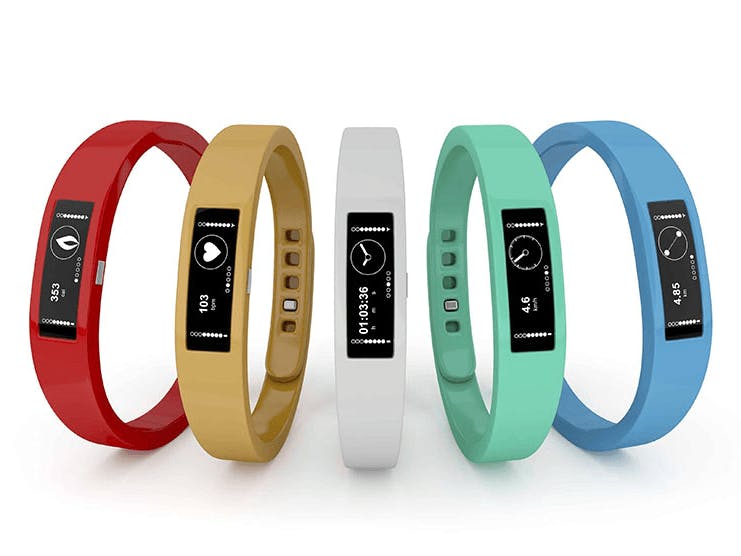
Fitness trackers do a lot more than count steps. Are you getting the most out of yours?
Mon-Thur 9am-7pm | Fri 9am-6pm EST
Fitness trackers, smartwatches, and other wearables offer an easy way to track your activity and get a more accurate picture of your health. But if you're using the device as it comes out of the box, you're missing out on its most powerful features. To get the most out of your fitness tracker, follow these 11 tips.
1. Talk to your doctor
Before starting any new fitness regimen, it's always smart to talk to your doctor. He or she can work with you to develop realistic fitness goals that take into account any health conditions you may have. You may also be able to take advantage of some great Medicare services – many of which are available at zero out-of-pocket cost – all designed to help you make healthy lifestyle changes.
2. Choose the right fitness tracker for you
There are a lot of fitness trackers out there. Doing a bit of research into what each one offers is a good place to start. In addition to online research, don't forget to talk to family and friends (and maybe your doctor from step 1). Odds are pretty high that at least one of them uses a fitness tracker.
Whatever your needs, you're sure to find a wearable to meet them. Some fitness devices seem to have more bells and whistles than a new Cadillac while others don't do much more than count your steps and how many minutes you spend being active each day. If your overall goal is increasing your level of activity, a low-cost option may be ideal. But if you're looking to gauge heart rate, monitor sleep patterns, track calories, and more, you probably want one of the more advanced fitness trackers.
3. Create a profile
To enjoy all of the benefits of a fitness tracker, you need to create a personal profile. This should include metrics like age, weight, height, and gender – all of which the device uses to track your progress and estimate caloric needs. Without a user profile, you're basically just wearing an expensive pedometer.
4. Download the app
Most fitness trackers have a mobile app that you can download to your phone or tablet. The app allows you to sync the data from your tracker to your smart device so you can easily review the data collected. If you do not have a smart device, you may be able to sync with your computer. Check the tracker's instruction manual for details.
While you're reading the manual, also look at how the device syncs. This may require a Bluetooth connection, or the tracker may have come with a dongle or cord that connects the tracker to your smartphone or computer.
5. Wear the tracker on your less dominant arm
By wearing your fitness tracker on your left wrist if you're right-handed (or vice versa for lefties), you reduce the risk of damaging the tracker. You're also less likely to track steps you haven't taken. You'll even get more accurate sleep data by wearing it on your non-dominant arm, if your wearable monitors that information.
6. Start slowly
Most fitness trackers have a default setting of 10,000 steps per day but allow you to change that goal – and others – to match your unique needs. Before you set those goals, though, it's a good idea to spend a week or so tracking your current activity levels. If you live an extremely sedentary life, walking only 1,000 steps per day, hitting that 10,000 steps goal is a tall order. Instead, work to increase your activity incrementally. It's not only safer, but it's also more sustainable. Give yourself a goal of 2,000 steps per day for week 1 and up that number every week until you reach 10,000 daily steps.
Of course, the opposite is also true. If you're a fairly active person, you likely have very different fitness goals.
7. Update your tracker regularly
Fitness trackers aren't "one and done" types of devices. As your health improves, your activity and calorie needs will change. That means you need to update your weight and age as you go, as well as any other metrics relevant to your fitness goals.
That also means updating your actual goals, too, not just your weight and age. As you reach fitness targets, it's important to set new ones. Again, talk to your doctor to ensure you do this safely.
8. Sync your device with other fitness apps
Most wearables let you sync your account with other fitness apps. One of the most popular is MyFitnessPal, which is an easy way to track calories. But there are loads of options out there – Noom, Map My Run, Strava, Weight Watchers, Fooducate. The best ones for you depend on your goals. Just search "fitness apps" in your favorite browser. Most of them offer free versions, which makes it really easy to test your options until you find the perfect fit.
9. Get social
Many people find it easier to stick with fitness goals when they aren't going it alone. Luckily, most fitness trackers let you add friends. Not only can you view each other's progress, you can even compete to see who got the most steps in that day, ran the fastest mile, or create other competitions.
10. Be consistent
It's important to be consistent when it comes to attaining health goals. So, remember to keep your fitness tracker charged so it's always ready to go. And, of course, make wearing it every day a habit.
11. Have fun
A fitness tracker should help motivate you to keep fit, but don't take it too seriously. After all, it's just a bunch of plastic and computer parts. It may miss some of your steps during the day, or miscalculate your heart rate or calories burned. That's okay. It's an aid, not a bible.
Also, don't be too hard on yourself if you miss a day or two. People get sick, life occasionally gets crazy, and sometimes you just need a day off. It's easy to beat yourself up when that happens; it's a lot harder to forgive yourself for being human and get back up on that horse.
Additional resources
- ClearMatch Medicare: Find a Medicare Plan
- MyFitnessPal



